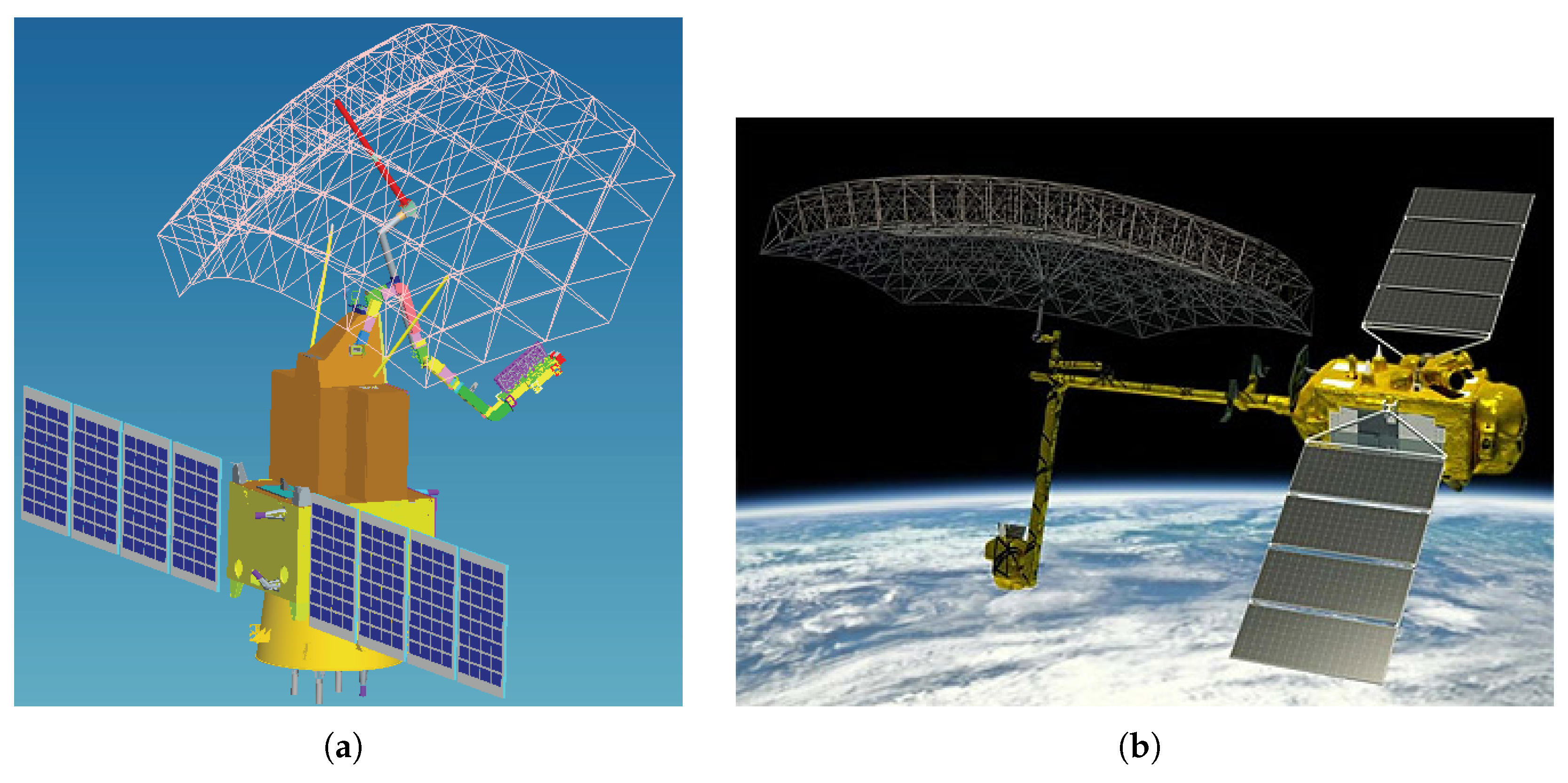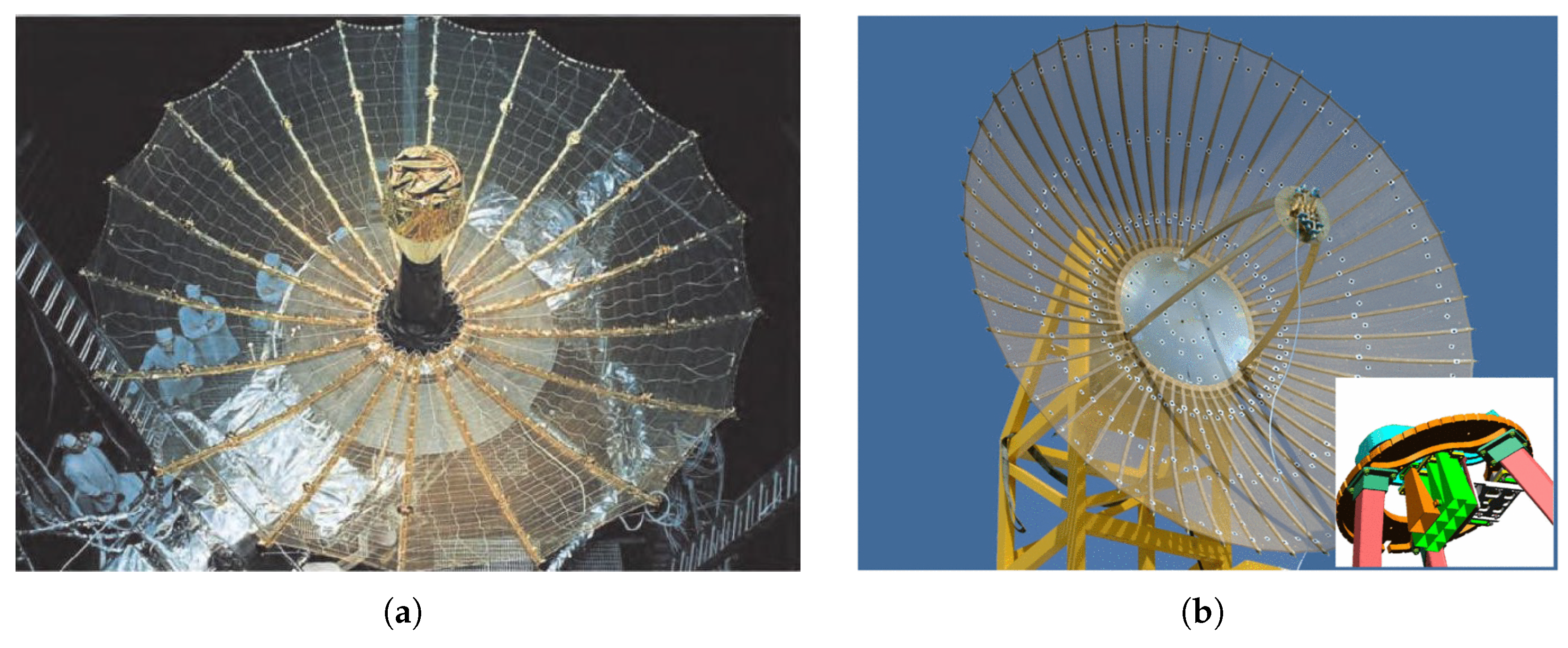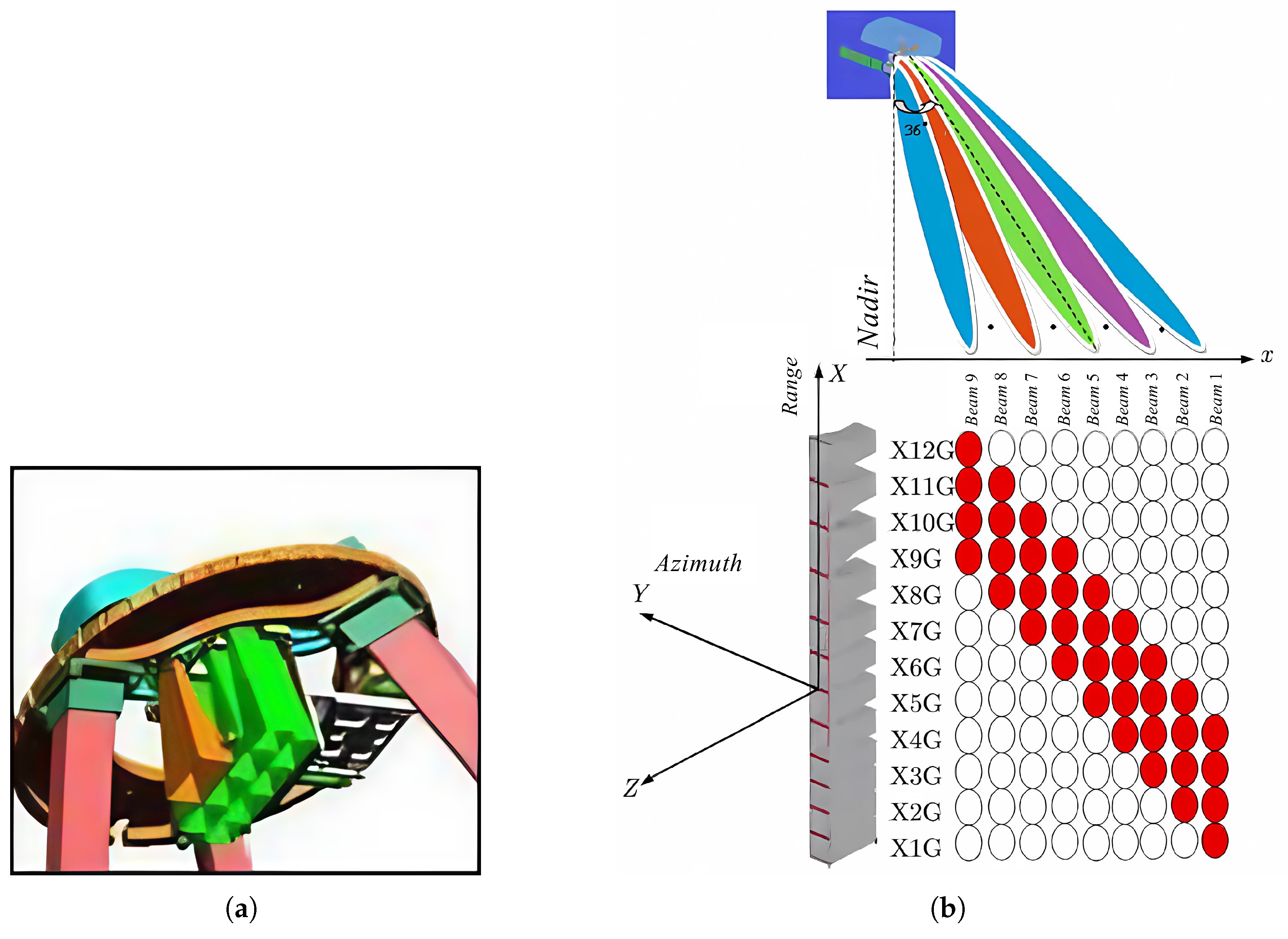The Development of a Spaceborne SAR Based on a Reflector Antenna
Abstract
1. Introduction
2. Principles and Classification of Reflector Antennas
2.1. Basic Principles of Reflector Antennas
2.2. Types and Characteristics of Reflector Antennas
2.2.1. Parabolic Reflector Antennas
2.2.2. Parabolic Cylindrical Reflector Antennas
2.2.3. Elliptical Reflector Antennas
2.2.4. Dual-Reflector Antennas
2.2.5. Spherical Reflector Antennas
2.2.6. Summary of Reflector Antenna Types and Characteristics
3. Reflector Antenna Configurations in Spaceborne SAR Systems
3.1. Deployable Antenna
3.1.1. Framework Deployable Antenna
3.1.2. Perimeter Truss Deployable Antennas
3.1.3. Radial Rib Deployable Antennas
3.1.4. Summary of Deployable Antennas
3.2. Feed Configurations for Reflector Antenna
3.2.1. Single-Beam Feed
3.2.2. Multi-Beam Feeds
3.2.3. Phased Array Feed (PAF)
3.2.4. Summary of Feed Configurations for Reflector Antennas
3.3. Reflector Antenna Configurations in Representative SAR Systems
4. Challenges and Development Trends in Reflector Antenna-Based SAR Technology
4.1. Emerging Techniques for Reflector Antenna-Based SAR
4.1.1. Reflector Antennas with DBF
4.1.2. Staggered SAR
4.1.3. SweepSAR
4.2. Challenges for Reflector Antenna-Based SAR
4.3. Risks for Reflector Antenna-Based SAR
4.3.1. On-Orbit Deployment Accuracy and Structural Stability
4.3.2. High-Power System Failure
4.3.3. Risk Mitigation Measures for Future Systems
4.4. Future Development Directions for Reflector Antenna-Based SAR
5. Conclusions
Author Contributions
Funding
Institutional Review Board Statement
Informed Consent Statement
Data Availability Statement
Conflicts of Interest
References
- Wiley, C.A. Synthetic Aperture Radars. IEEE Trans. Aerosp. Electron. Syst. 1985, AES-21, 440–443. [Google Scholar] [CrossRef]
- Brown, W.M. Synthetic Aperture Radar. IEEE Trans. Aerosp. Electron. Syst. 1967, AES-3, 217–229. [Google Scholar] [CrossRef]
- Moreira, A.; Prats-Iraola, P.; Younis, M.; Krieger, G.; Hajnsek, I.; Papathanassiou, K.P. A Tutorial on Synthetic Aperture Radar. IEEE Geosci. Remote Sens. Mag. 2013, 1, 6–43. [Google Scholar] [CrossRef]
- Cumming, I.G.; Wong, F.H. Digital Signal Processing of Synthetic Aperture Radar Data: Algorithms and Implementation; Artech House Publishers: Norwood, MA, USA, 2004. [Google Scholar]
- Soumekh, M. Synthetic Aperture Radar Signal Processing; John Wiley & Sons: New York, NY, USA, 1999. [Google Scholar]
- Curlander, J.C.; Mcdonough, R.N. Synthetic Aperture Radar: Systems and Signal Processing; John Wiley & Sons: New York, NY, USA, 1991. [Google Scholar]
- Reigber, A.; Scheiber, R.; Jager, M.; Prats-Iraola, P.; Hajnsek, I.; Jagdhuber, T.; Papathanassiou, K.P.; Nannini, M.; Aguilera, E.; Baumgartner, S.; et al. Very-High-Resolution Airborne Synthetic Aperture Radar Imaging: Signal Processing and Applications. Proc. IEEE 2013, 101, 759–783. [Google Scholar] [CrossRef]
- Bao, Z.; Xing, M.-D.; Wang, T. Radar Imaging Technology: Radar Technology Series; Publishing House of Electronics Industry: Beijing, China, 2005. [Google Scholar]
- Balanis, C.A. Antenna Theory: Analysis and Design. IEEE Antennas Propag. Soc. Newsl. 2003, 24, 28–29. [Google Scholar] [CrossRef]
- Stutzman, W.L.; Thiele, G.A. Antenna Theory and Design; Wiley: New York, NY, USA, 1998. [Google Scholar] [CrossRef]
- Clarricoats, P.; Poulton, G. High-Efficiency Microwave Reflector Antennas—A Review. Proc. IEEE 1977, 65, 1470–1504. [Google Scholar] [CrossRef]
- Saunders, R.S.; Spear, A.J.; Allin, P.C.; Austin, R.S.; Berman, A.L.; Chandlee, R.C.; Clark, J.; Decharon, A.V.; De Jong, E.M.; Griffith, D.G.; et al. Magellan Mission Summary. J. Geophys. Res. Planets 1992, 97, 13067–13090. [Google Scholar] [CrossRef]
- Castelletti, D.; Farquharson, G.; Stringham, C.; Eddy, D. Operational Readiness of the Capella Space SAR System. In Proceedings of the IGARSS 2020–2020 IEEE International Geoscience and Remote Sensing Symposium, Waikoloa, HI, USA, 26 September–2 October 2020; pp. 3571–3573. [Google Scholar] [CrossRef]
- Naftaly, U.; Levy-Nathansohn, R. Overview of the TECSAR Satellite Hardware and Mosaic Mode. IEEE Geosci. Remote Sens. Lett. 2008, 5, 423–426. [Google Scholar] [CrossRef]
- Huber, S.; De Almeida, F.Q.; Villano, M.; Younis, M.; Krieger, G.; Moreira, A. Tandem-L: A Technical Perspective on Future Spaceborne SAR Sensors for Earth Observation. IEEE Trans. Geosci. Remote Sens. 2018, 56, 4792–4807. [Google Scholar] [CrossRef]
- Kellogg, K.; Hoffman, P.; Standley, S.; Shaffer, S.; Rosen, P.; Edelstein, W.; Dunn, C.; Baker, C.; Barela, P.; Shen, Y.; et al. NASA-ISRO Synthetic Aperture Radar (NISAR) Mission. In Proceedings of the 2020 IEEE Aerospace Conference, Big Sky, MT, USA, 7–14 March 2020; pp. 1–21. [Google Scholar] [CrossRef]
- Lange, S. SAR-Lupe satellites launched. Strategie Tech. (Int. Ed.) 2007, 2, 13–15. [Google Scholar]
- Yu, W.-D.; Yang, R.L.; Deng, Y.K.; Zhao, F.J.; Lei, H. The Load Design and Implementation of HJ-1-C Space-borne SAR. J. Radars 2014, 3, 256–265. [Google Scholar] [CrossRef]
- Farquharson, G.; Castelletti, D.; De, S.; Stringham, C.; Yague, N.; Bes, V.C.; Ryu, J.; Goncharenko, Y. The New Capella Space Satellite Generation: Acadia. In Proceedings of the IGARSS 2023–2023 IEEE International Geoscience and Remote Sensing Symposium, Pasadena, CA, USA, 16–21 July 2023; pp. 1513–1516. [Google Scholar] [CrossRef]
- Zhong, S.-S. Antenna Theory and Techniques; Publishing House of Electronics Industry: Beijing, China, 2015. [Google Scholar]
- Lo, Y.T.; Lee, S.W. Antenna Handbook: Theory, Applications, and Design; Springer Science & Business Media: Berlin/Heidelberg, Germany, 2013. [Google Scholar]
- Lin, Y.-Q. Present and Future of the Spaceborne Synthetic Aperture Radar System. Mod. Radar 2009, 31, 10–13. [Google Scholar]
- Sletten, C.J. The Theory of Reflector Antennas; Air Force Cambridge Research Laboratories, Office of Aerospace Research, United States Air Force: Wright-Patterson Air Force Base, OH, USA, 1966. [Google Scholar]
- Shafai, L.; Sharma, S.; Balaji, B.; Damini, A.; Haslam, G. Multiple Phase Center Performance of Reflector Antennas Using a Dual Mode Horn. IEEE Trans. Antennas Propag. 2006, 54, 3407–3417. [Google Scholar] [CrossRef]
- Pontoppidan, K. GRASP9-Technical Description; Ticra: Copenhagen, Denmark, 2008. [Google Scholar]
- Agrawal, P.; Anderson, M.; Card, M. Preliminary Design of Large Reflectors with Flat Facets. IEEE Trans. Antennas Propag. 1981, 29, 688–694. [Google Scholar] [CrossRef]
- Li, T. A Study of Spherical Reflectors as Wide-Angle Scanning Antennas. IRE Trans. Antennas Propag. 1959, 7, 223–226. [Google Scholar] [CrossRef]
- Rudge, A.; Adatia, N. Offset-Parabolic-Reflector Antennas: A Review. Proc. IEEE 1978, 66, 1592–1618. [Google Scholar] [CrossRef]
- Potter, P.D.; Merrick, W.D.; Ludwig, A.C. Big Antenna Systems for Deep-Space Communications. Astronaut. Aeronaut. 1966, 4, 84–95. [Google Scholar]
- Zheng, S.-K.; Ji, Y.-Z.; Cui, Z.-Y.; Fang, Y.-G.; Zhou, L.-P. Design and Analysis of HJ-1-C Satellite SAR Antenna. J. Radars 2014, 3, 266–273. [Google Scholar] [CrossRef]
- Yuan, J.-J.; Yu, D.-Y. Design and Analysis of Satellite Structures; China Astronautic Publishing House: Beijing, China, 2004. [Google Scholar]
- Le Vine, D.; Griffis, A.; Swift, C.; Jackson, T. ESTAR: A Synthetic Aperture Microwave Radiometer for Remote Sensing Applications. Proc. IEEE 1994, 82, 1787–1801. [Google Scholar] [CrossRef]
- Wang, L.; Gao, W.-J.; Lei, H.; Liu, X.-M.; Xiong, Y.-H. Analysis for the Pattern of Deployable Truss ReflectorAntenna with Substitute Physical Optics Method. J. Electron. Inf. Technol. 2013, 35, 1484–1489. [Google Scholar] [CrossRef]
- Duan, B.-Y. The State-of-the-art and Development Trend of Large Space-borne Deployable Antenna. Electro-Mech. Eng. 2017, 33, 1–14. [Google Scholar] [CrossRef]
- Ma, X.-F.; Li, Y.; Xiao, Y.; Zheng, S.-K.; Huang, Z.-R.; Feng, T. Development and Tendency of Large Space Deployable Antenna Reflector. Space Electron. Technol. 2018, 15, 16–26. [Google Scholar]
- Wei, J.-F.; Guan, F.-L.; Zhou, L.-P.; Wang, Y.; Liu, T.-L. Design and Analysis of Deployable Parabolic Truss-Mesh Reflector Antenna. Chin. Space Sci. Technol. 2002, 5, 63–68. [Google Scholar]
- Hu, F.; Song, Y.-P.; Zheng, S.-K.; Huang, Z.-R.; Zhu, J.L. Advances and Trends in Space Truss Deployable Antennae. J. Astronaut. 2018, 39, 111–120. [Google Scholar]
- Zhang, R.-N.; Jiang, X.-P. System Design and In-orbit Verification of the HJ-1-C SAR Satellite. J. Radars 2014, 3, 249–255. [Google Scholar] [CrossRef]
- eoPortal. Kondor-FKA 1 Illustration. 2024. Last Updated: 14 August 2024. Available online: https://directory.eoportal.org/satellite-missions/kondor-fka#performance-specifications (accessed on 4 June 2025).
- Thomson, M. The AstroMesh Deployable Reflector. In Proceedings of the IEEE Antennas and Propagation Society International Symposium, 1999 Digest, Held in Conjunction with: USNC/URSI National Radio Science Meeting (Cat. No.99CH37010), Orlando, FL, USA,, 11–16 July 1999; Volume 3, pp. 1516–1519. [Google Scholar] [CrossRef]
- You, G.-Q. Structual Optimization of Flexible Cable Net Deployable Antenna. Master’s Thesis, Xidian University, Xi’an, China, 2005. [Google Scholar]
- Zhou, M.-H. Shape-State Analysis of Hoop Truss Deployable Antenna of Mesh Reflector. Master’s Thesis, Xidian University, Xi’an, China, 2008. [Google Scholar]
- Krieger, G.; Hajnsek, I.; Papathanassiou, K.; Eineder, M.; Younis, M.; De Zan, F.; Prats, P.; Huber, S.; Werner, M.; Fiedler, H.; et al. The Tandem-L Mission Proposal: Monitoring Earth’s Dynamics with High Resolution SAR Interferometry. In Proceedings of the 2009 IEEE Radar Conference, Pasadena, CA, USA, 4–8 May 2009; pp. 1–6. [Google Scholar] [CrossRef]
- Krieger, G.; Hajnsek, I.; Papathanassiou, K.; Eineder, M.; Younis, M.; Zan, F.D.; Lopez-Dekker, P.; Huber, S.; Werner, M.; Prats, P.; et al. Tandem-L: A Mission for Monitoring Earth System Dynamics with High Resolution SAR Interferometry. In Proceedings of the 8th European Conference on Synthetic Aperture Radar, Aachen, Germany, 7–10 June 2010; pp. 1–4. [Google Scholar]
- Krieger, G.; Hajnsek, I.; Papathanassiou, K.; Eineder, M.; Younis, M.; De Zan, F.; Huber, S.; Lopez-Dekker, P.; Prats, P.; Werner, M.; et al. Tandem-L: An Innovative Interferometric and Polarimetric SAR Mission to Monitor Earth System Dynamics with High Resolution. In Proceedings of the 2010 IEEE International Geoscience and Remote Sensing Symposium, Honolulu, HI, USA, 25–30 July 2010; pp. 253–256. [Google Scholar] [CrossRef]
- Moreira, A.; Krieger, G.; Younis, M.; Hajnsek, I.; Papathanassiou, K.; Eineder, M.; De Zan, F. Tandem-L: A Mission Proposal for Monitoring Dynamic Earth Processes. In Proceedings of the 2011 IEEE International Geoscience and Remote Sensing Symposium, Vancouver, BC, Canada, 24–29 July 2011; pp. 1385–1388. [Google Scholar] [CrossRef]
- Moreira, A.; Krieger, G.; Hajnsek, I.; Papathanassiou, K.; Younis, M.; Lopez-Dekker, P.; Huber, S.; Villano, M.; Pardini, M.; Eineder, M.; et al. Tandem-L: A Highly Innovative Bistatic SAR Mission for Global Observation of Dynamic Processes on the Earth’s Surface. IEEE Geosci. Remote Sens. Mag. 2015, 3, 8–23. [Google Scholar] [CrossRef]
- Bachmann, M.; Borla Tridon, D.; De Zan, F.; Krieger, G.; Zink, M. Tandem-L Observation Concept—An Acquisition Scenario for the Global Scientific Mapping Machine. In Proceedings of the EUSAR 2016: 11th European Conference on Synthetic Aperture Radar, Hamburg, Germany, 6–9 June 2016; pp. 1–5. [Google Scholar]
- Huber, S.; Villano, M.; Younis, M.; Krieger, G.; Moreira, A.; Grafmueller, B.; Wolters, R. Tandem-L: Design Concepts for a Next-Generation Spaceborne SAR System. In Proceedings of the EUSAR 2016: 11th European Conference on Synthetic Aperture Radar, Hamburg, Germany, 6–9 June 2016; pp. 1–5. [Google Scholar]
- Sanjuan-Ferrer, M.J.; Pardini, M.; Borla Tridon, D.; Lopez-Dekker, P.; Papathanassiou, K.; Bachmann, M. Product-Level PerformanceModels for the Tandem-LMission: Forest Structure Case Study. In Proceedings of the EUSAR 2016: 11th European Conference on Synthetic Aperture Radar, Hamburg, Germany, 6–9 June 2016; pp. 1–6. [Google Scholar]
- Xaypraseuth, P.; Satish, R.; Chatterjee, A. NISAR Spacecraft Concept Overview: Design Challenges for a Proposed Flagship Dual-Frequency SAR Mission. In Proceedings of the 2015 IEEE Aerospace Conference, Big Sky, MT, USA, 7–14 March 2015; pp. 1–11. [Google Scholar] [CrossRef]
- Qi, X. Design and Deployment Dynamics of Ring Truss-Type Deployable Antenna Mechanism; Harbin Institute of Technology: Harbin, China, 2016. [Google Scholar]
- eoPortal. Tandem-L Satellite. 2016. Last Updated: 16 September 2016. Available online: https://directory.eoportal.org/satellite-missions/tandem-l#eop-quick-facts-section (accessed on 4 June 2025).
- Liu, M.-Z.; Gao, G.F. Advances in the Study on Structure for Space Deployable Antenna. J. Stronautics 2003, 1, 82–87. [Google Scholar]
- Li, T.; Ma, X. Technologies of Large Deployable Space Antennas. Space Electron. Technol. 2012, 9, 35–43. [Google Scholar]
- Sharay, Y.; Naftaly, U. TECSAR: Design Considerations and Programme Status. IEE Proc.-Radar, Sonar Navig. 2006, 153, 117. [Google Scholar] [CrossRef]
- eoPortal. RISAT-2 (Radar Imaging Satellite-2).2023. Last Updated: 10 August 2023. Available online: https://www.eoportal.org/satellite-missions/risat-2#eop-quick-facts-section (accessed on 4 June 2025).
- Wang, N.; Lang, Y.; Yu, W.; Ni, J.; Zheng, M. Application of Phased Array Feed Reflector Antenna in Spaceborne SAR. Spacecr. Eng. 2024, 33, 11–17. [Google Scholar]
- Lin, C. Antenna Engineering Handbook; Publishing House of Electronics Industry: Beijing, China, 2002. [Google Scholar]
- Bahadori, K. Spaceborne Reflector Antennas for Advanced Remote Sensing Applications; University of California: Los Angeles, CA, USA, 2008. [Google Scholar]
- Chen, X.; Yu, H.; Wang, X.; Feng, F.; Wang, Z.; Zhang, R.; Liu, S.; Liu, L. Attitude Control Strategy for Multi-aspect Imaging of SAR Satellite with Reflector Antenna System. Spacecr. Eng. 2023, 32, 42–46. [Google Scholar]
- Ivashina, M.V.; Iupikov, O.; Maaskant, R.; van Cappellen, W.A.; Oosterloo, T. An Optimal Beamforming Strategy for Wide-Field Surveys With Phased-Array-Fed Reflector Antennas. IEEE Trans. Antennas Propag. 2011, 59, 1864–1875. [Google Scholar] [CrossRef]
- Freeman, A.; Johnson, W.; Huneycutt, B.; Jordan, R.; Hensley, S.; Siqueira, P.; Curlander, J. The “Myth” of the Minimum SAR Antenna Area Constraint. IEEE Trans. Geosci. Remote Sens. 2000, 38, 320–324. [Google Scholar] [CrossRef]
- Song, R.; Wang, W.; Yu, W. The Latest Developments in Spaceborne High-Resolution Wide-Swath SAR Systems and Imaging Methods. Sensors 2024, 24, 5978. [Google Scholar] [CrossRef]
- Gebert, N.; Krieger, G.; Moreira, A. Digital Beamforming on Receive: Techniques and Optimization Strategies for High-Resolution Wide-Swath SAR Imaging. IEEE Trans. Aerosp. Electron. Syst. 2009, 45, 564–592. [Google Scholar] [CrossRef]
- Kare, J.T. Moving Receive Beam Method and Apparatus for Synthetic Aperture Radar. US Patent 6,175,326, 23 January 2001. Assignee: Regents of University of California: Oakland, CA, USA; DOE Contract Number: W-7405-ENG-48. Available online: https://patents.google.com/patent/US6175326B1/en (accessed on 4 June 2025).
- Süß, M.; Grafmüller, B.; Zahn, R. A Novel High Resolution, Wide Swath SAR System. In Proceedings of the IGARSS 2001. Scanning the Present and Resolving the Future. Proceedings. IEEE 2001 International Geoscience and Remote Sensing Symposium, Sydney, NSW, Australia, 9–13 July 2001; (Cat. No. 01CH37217). IEEE: New York, NY, USA, 2001; Volume 3, pp. 1013–1015. [Google Scholar]
- Suess, M.; Wiesbeck, W. Side-Looking Synthetic Aperture Radar System. Eur. Pat. EP 2002, 1, 487. [Google Scholar]
- Younis, M.; Huber, S.; Patyuchenko, A.; Bordoni, F.; Krieger, G. Performance Comparison of Reflector- and Planar-Antenna Based Digital Beam-Forming SAR. Int. J. Antennas Propag. 2009, 2009, 1–13. [Google Scholar] [CrossRef]
- Huber, S.; Younis, M.; Patyuchenko, A.; Krieger, G.; Moreira, A. Spaceborne Reflector SAR Systems with Digital Beamforming. IEEE Trans. Aerosp. Electron. Syst. 2012, 48, 3473–3493. [Google Scholar] [CrossRef]
- Younis, M.; De Almeida, F.Q.; Villano, M.; Huber, S.; Krieger, G.; Moreira, A. Digital Beamforming for Spaceborne Reflector-Based Synthetic Aperture Radar, Part 1: Basic Imaging Modes. IEEE Geosci. Remote Sens. Mag. 2021, 9, 8–25. [Google Scholar] [CrossRef]
- Younis, M.; Huber, S.; Patyuchenko, A.; Bordoni, F.; Krieger, G. Digital beam-forming for spaceborne reflector- and planar-antenna SAR — A system performance comparison. In Proceedings of the 2009 IEEE International Geoscience and Remote Sensing Symposium, Cape Town, South Africa, 12–17 July 2009; Volume 3, pp. III-733–III-736. [Google Scholar] [CrossRef]
- Krieger, G.; Gebert, N.; Younis, M.; Bordoni, F.; Patyuchenko, A.; Moreira, A. Advanced Concepts for Ultra-Wide-Swath SAR Imaging. In Proceedings of the 7th European Conference on Synthetic Aperture Radar, Friedrichshafen, Germany, 2–5 June 2008; pp. 1–4. [Google Scholar]
- Huber, S. Spaceborne SAR Systems with Digital Beamforming and Reflector Antenna Deutsches Zentrum für Luft- und Raumfahrt (DLR), Cologne, Germany, 2014. Available online: https://elib.dlr.de/93190/ (accessed on 4 June 2025).
- Huber, S.; Younis, M.; Krieger, G.; Moreira, A. Advanced Spaceborne SAR Systems with Array-Fed Reflector Antennas. In Proceedings of the 2015 IEEE Radar Conference (RadarCon), Arlington, VA, USA, 10–15 May 2015; pp. 0253–0258. [Google Scholar] [CrossRef]
- Krieger, G.; Gebert, N.; Younis, M.; Moreira, A. Advanced Synthetic Aperture Radar Based on Digital Beamforming and Waveform Diversity. In Proceedings of the 2008 IEEE Radar Conference, Rome, Italy, 26–30 May 2008; pp. 1–6. [Google Scholar] [CrossRef]
- Krieger, G.; Younis, M.; Huber, S.; Bordoni, F.; Patyuchenko, A.; Kim, J.; Laskowski, P.; Villano, M.; Rommel, T.; Lopez-Dekker, P.; et al. Digital Beamforming and MIMO SAR: Review and New Concepts. In Proceedings of the EUSAR 2012, 9th European Conference on Synthetic Aperture Radar, Nuremberg, Germany, 23–26 April 2012; pp. 11–14. [Google Scholar]
- Villano, M.; Krieger, G.; Moreira, A. Staggered SAR: High-Resolution Wide-Swath Imaging by Continuous PRI Variation. IEEE Trans. Geosci. Remote Sens. 2014, 52, 4462–4479. [Google Scholar] [CrossRef]
- Villano, M.; Krieger, G.; Moreira, A. A Novel Processing Strategy for Staggered SAR. IEEE Geosci. Remote Sens. Lett. 2014, 11, 1891–1895. [Google Scholar] [CrossRef]
- Villano, M. Staggered Synthetic Aperture Radar; DLR, Deutsches Zentrum für Luft-und Raumfahrt: Stuttgart, Germany, 2016. [Google Scholar]
- Heer, C.; Shutie, P. Digital Beam Forming Synthetic Aperture Radar. In Proceedings of the IEEE MTT-S International Microwave Symposium Digest, Long Beach, CA, USA, 17 June 2005; pp. 1627–1630. [Google Scholar] [CrossRef]
- Freeman, A.; Krieger, G.; Rosen, P.; Younis, M.; Johnson, W.T.K.; Huber, S.; Jordan, R.; Moreira, A. SweepSAR: Beam-forming on Receive Using a Reflector-Phased Array Feed Combination for Spaceborne SAR. In Proceedings of the 2009 IEEE Radar Conference, Pasadena, CA, USA, 4–8 May 2009; pp. 1–9. [Google Scholar] [CrossRef]
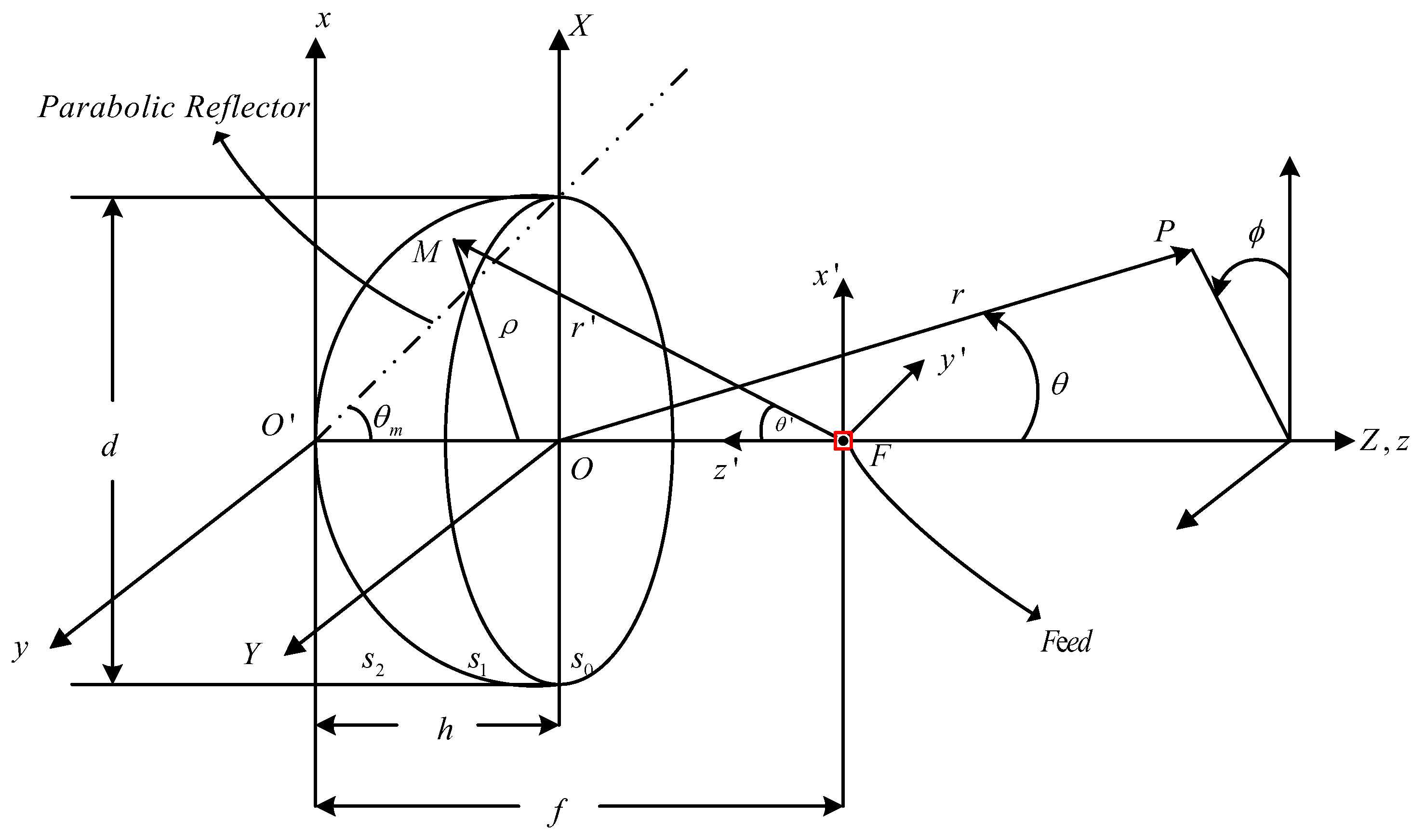
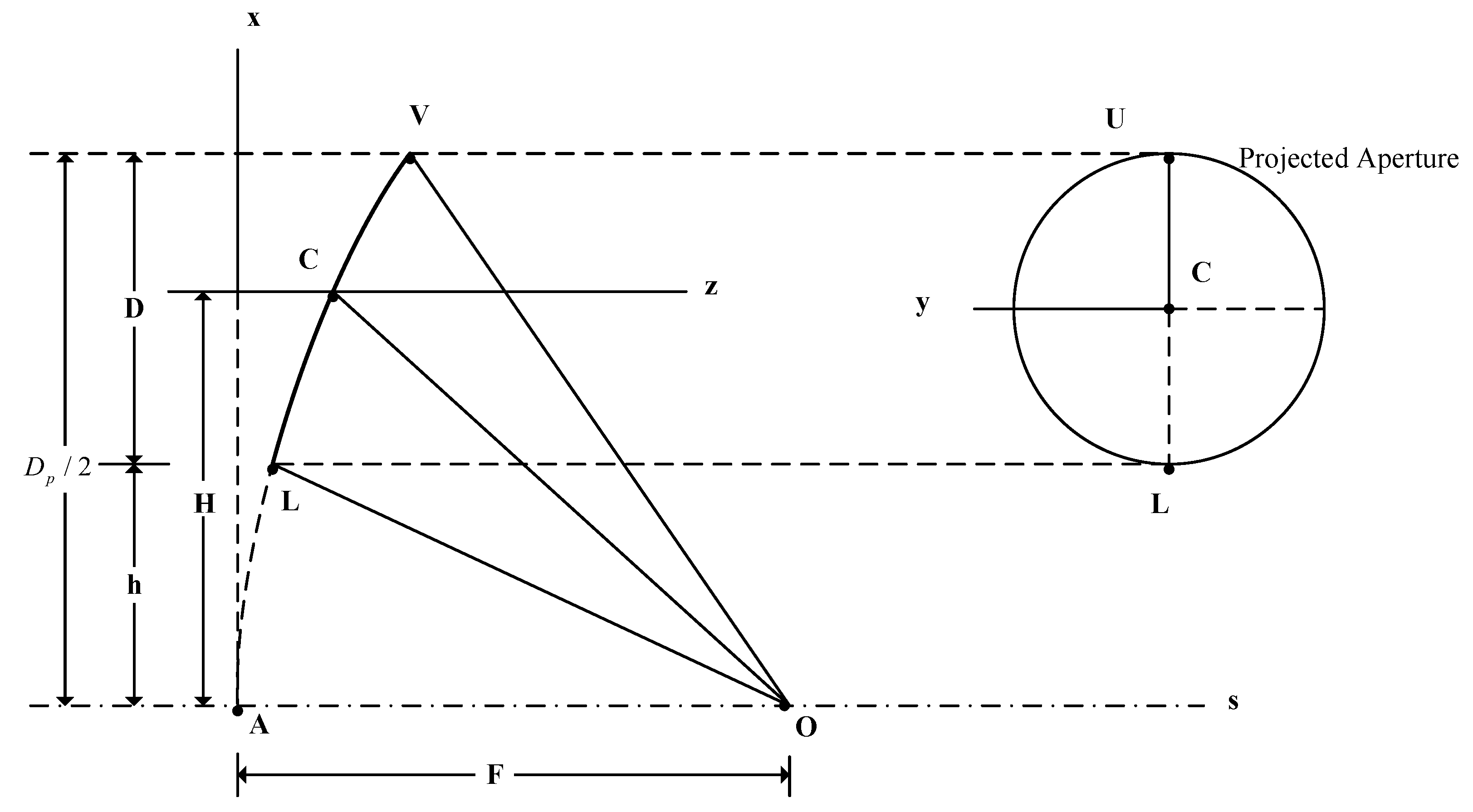
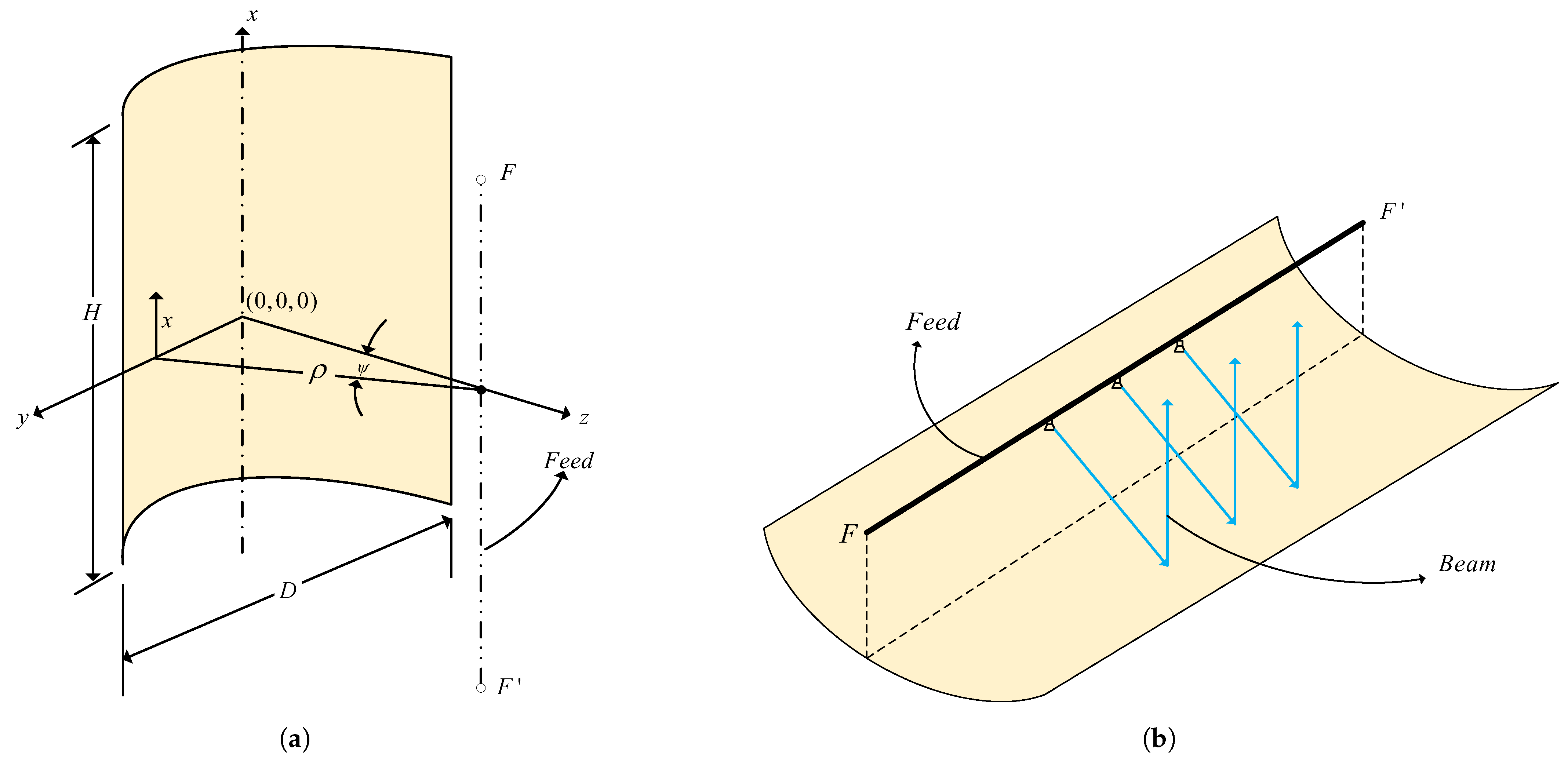

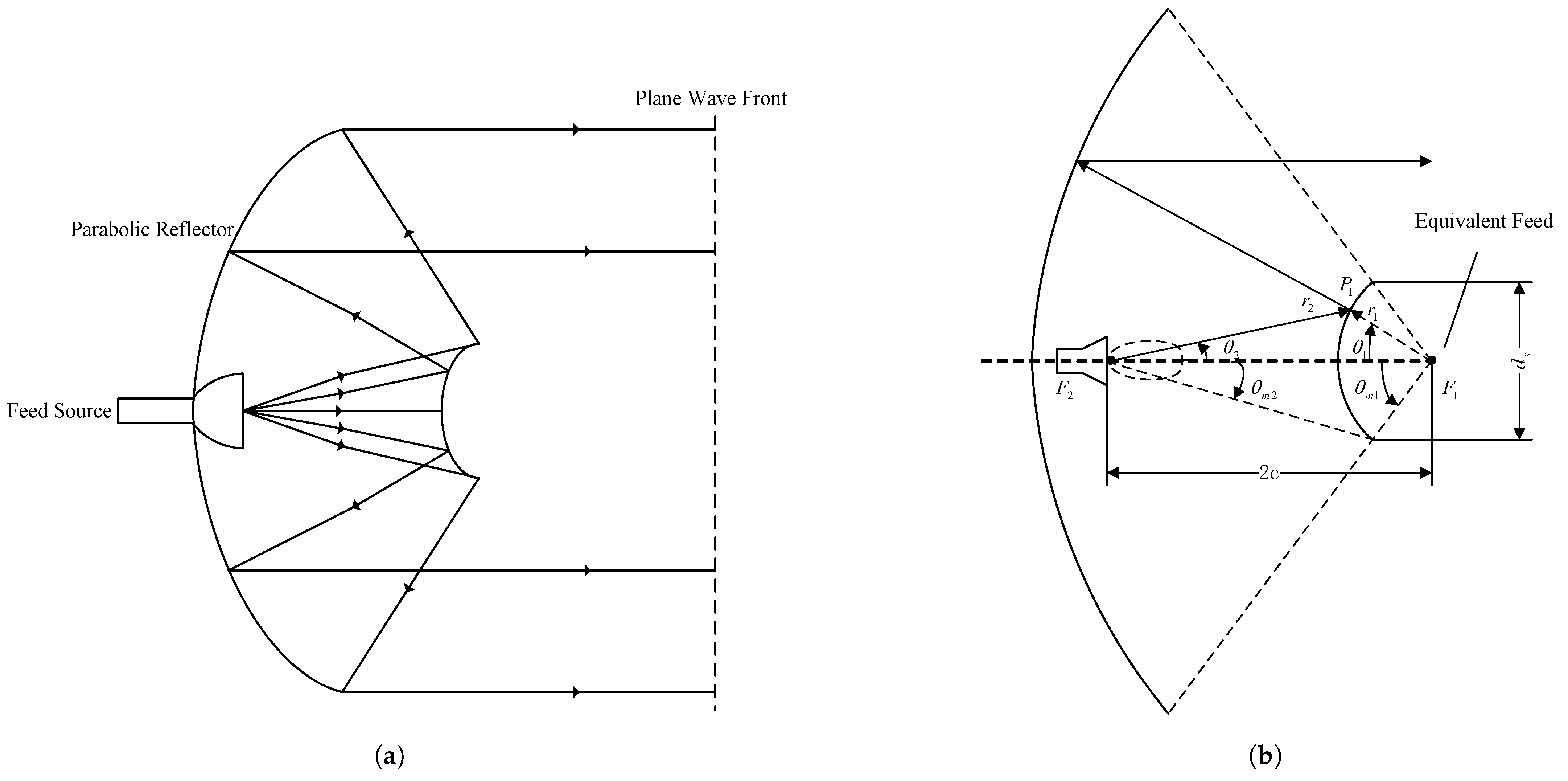



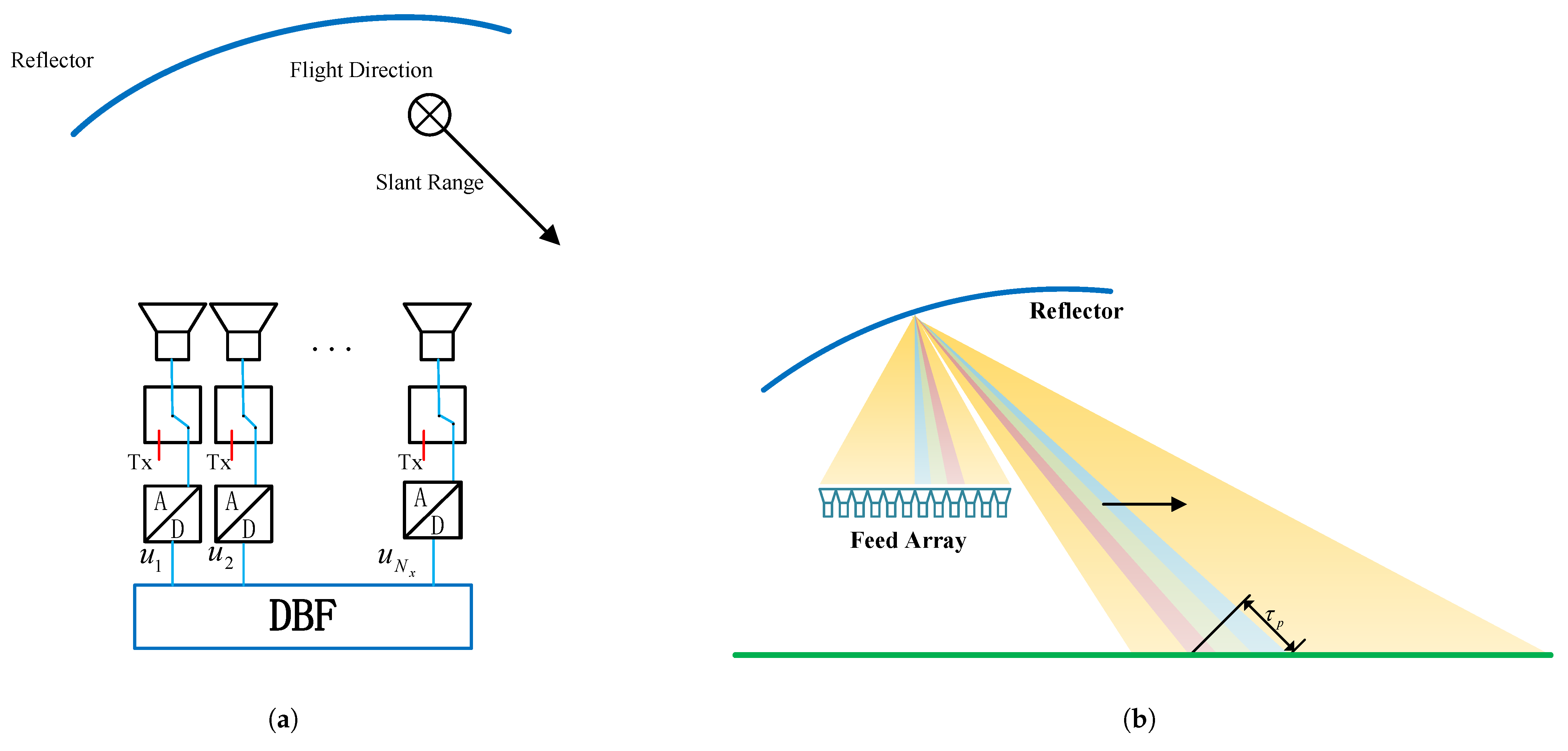
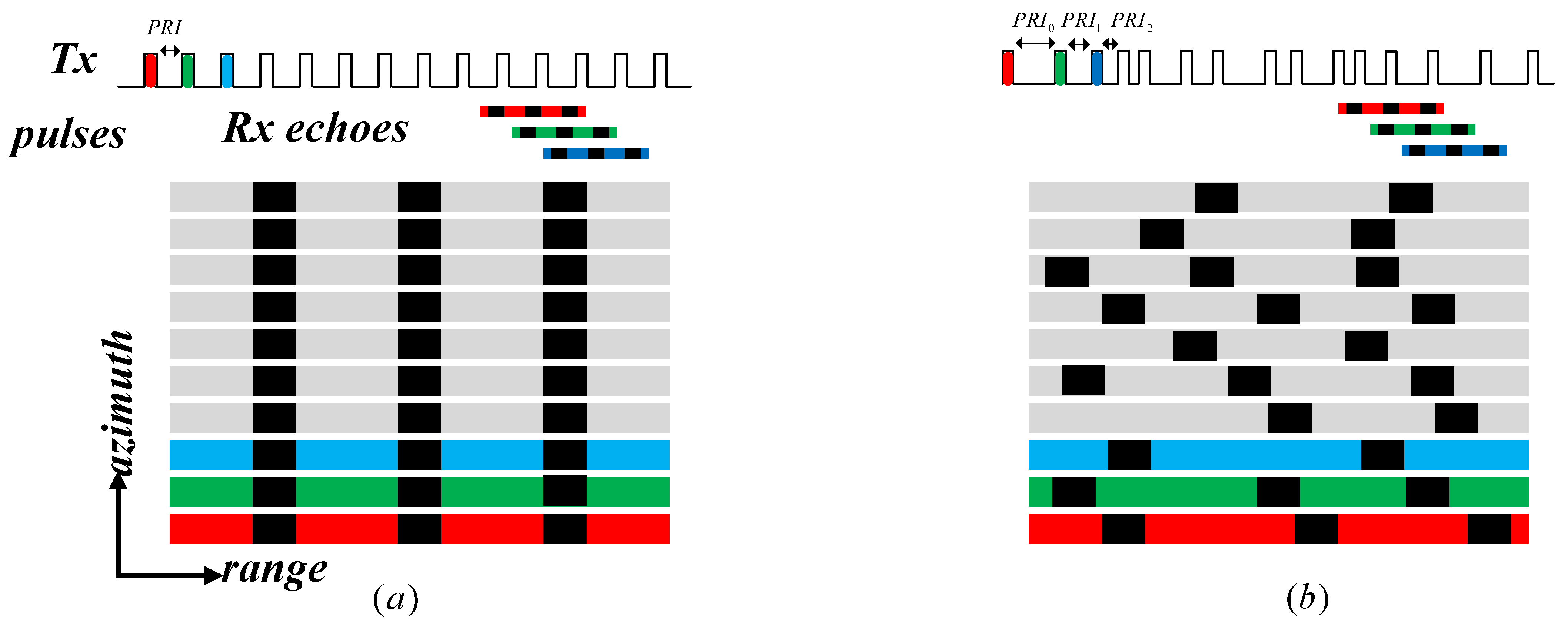

| Reflector Antenna Types | Characteristics | Representative Spaceborne SAR Systems |
|---|---|---|
| Parabolic Reflector Antenna | High gain, narrow beam, strong directivity, simple structure | Lacrosse, Magellan, SAR-Lupe, HJ-1-C, Qilu-1, Acadia, Neptune-01, TecSAR, RISAT-2 |
| Parabolic Cylindrical Reflector Antenna | Line source feed, suitable for wide-angle scanning | - |
| Elliptical Reflector Antenna | Dual-focus design, flexible beam control | HJ-2-E/F |
| Dual-Reflector Antenna | Two-reflector system, compact feed placement, low feedline loss | QPS-SAR |
| Spherical Reflector Antenna | Spherical surface, suitable for wide-angle coverage | - |
| Deployable Antenna Type | Characteristics | Spaceborne SAR Applications |
|---|---|---|
| Framework-Based | High deployment stiffness, excellent thermal stability, scalable modular assembly, precise surface control, but heavier structure | HJ-1-C (China, 2012), Qilu-1 (China, 2021), Kondor-FKA No.2 (Russia, 2024) |
| Perimeter Truss-Based | High deployment ratio, simplified structure, lightweight design | Acadia (USA, 2023), Tandem-L (Germany), NISAR (USA, India), EOS SAR (USA) |
| Radial Rib-Based | Simple structure, reliable deployment, high stiffness | TecSAR (Israel, 2008), RISAT-2 (India, 2009), QPS-SAR (Japan, 2019), Umbra (USA, 2021), Neptune-01 (China, 2024) |
| Feed Type | Characteristics | Spaceborne SAR Applications |
|---|---|---|
| Single-Beam Feed | Simple design, cost-effective | Qilu-1 (China, 2021) |
| Multi-Beam Feeds | Enables beam scanning and reconfiguration, but with limited and discontinuous scanning angles | TecSAR (Israel, 2008), RISAT-2 (India, 2009), HJ-1-C (China, 2012) |
| Phased Array Feed (PAF) | Provides larger scanning angles, continuous beam steering, and higher flexibility and reliability than multi-beam feeds | HJ-2-E/F (China) |
| SAR System (Country, Year) | Feed Type | Reflector Structure Type | System Characteristics |
|---|---|---|---|
| SAR-Lupe (Germany, 2006–2008) | Single-Beam Feed | Rigid Reflector antenna | Compact rigid antenna, military imaging |
| TECSAR (Israel, 2008) | Multi-Beam Feeds | Radial Rib Deployable Antenna | Lightweight deployable reflector, 3.6 m aperture |
| RISAT-2 (India, 2009) | Multi-Beam Feeds | Radial Rib Deployable Antenna | 3.6 m diameter mesh reflector, all-weather surveillance |
| HJ-1-C (China, 2012) | Multi-Beam Feeds | Framework Deployable Antenna | Dual-polarized X-band SAR, multi-mode operation |
| QPS-SAR (Japan, 2019) | Single-Beam Feed | Dual-Reflector Antenna | 3.6 m deployable reflector, lightweight small satellite SAR |
| Qilu-1 (China, 2021) | Single-Beam Feed | Framework Deployable Antenna | Ku-band, high-resolution lightweight SAR, total weight 50 kg |
| Acadia (USA, 2023) | Single-Beam Feed | Perimeter Truss Deployable Antenna | 8 m2 reflector, high revisit rate, commercial small satellite |
| HJ-2-E/F (China, upcoming) | Phased Array Feed | Framework Deployable Antenna | World’s first SAR system with phased array feed and reflector antenna |
| Tandem-L (Germany, upcoming) | Multi-Beam Feeds | Perimeter Truss Deployable Antenna | DBF-based reflector SAR, used for deformation and biomass monitoring |
| NISAR (India/USA, upcoming) | Multi-Beam Feeds | Perimeter Truss Deployable Antenna | Dual-frequency (L/S-band), 12 m deployable mesh, wide-swath InSAR |
Disclaimer/Publisher’s Note: The statements, opinions and data contained in all publications are solely those of the individual author(s) and contributor(s) and not of MDPI and/or the editor(s). MDPI and/or the editor(s) disclaim responsibility for any injury to people or property resulting from any ideas, methods, instructions or products referred to in the content. |
© 2025 by the authors. Licensee MDPI, Basel, Switzerland. This article is an open access article distributed under the terms and conditions of the Creative Commons Attribution (CC BY) license (https://creativecommons.org/licenses/by/4.0/).
Share and Cite
Huang, Y.; Yu, W.; Lin, Q.; Li, W.; Feng, Y. The Development of a Spaceborne SAR Based on a Reflector Antenna. Remote Sens. 2025, 17, 2432. https://doi.org/10.3390/rs17142432
Huang Y, Yu W, Lin Q, Li W, Feng Y. The Development of a Spaceborne SAR Based on a Reflector Antenna. Remote Sensing. 2025; 17(14):2432. https://doi.org/10.3390/rs17142432
Chicago/Turabian StyleHuang, Yongfei, Weidong Yu, Qiang Lin, Wenbao Li, and Yihang Feng. 2025. "The Development of a Spaceborne SAR Based on a Reflector Antenna" Remote Sensing 17, no. 14: 2432. https://doi.org/10.3390/rs17142432
APA StyleHuang, Y., Yu, W., Lin, Q., Li, W., & Feng, Y. (2025). The Development of a Spaceborne SAR Based on a Reflector Antenna. Remote Sensing, 17(14), 2432. https://doi.org/10.3390/rs17142432






